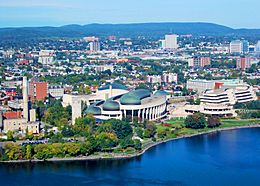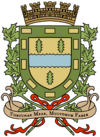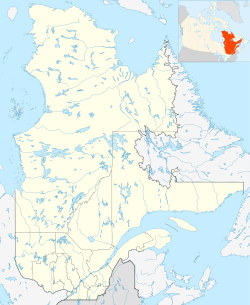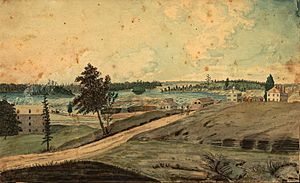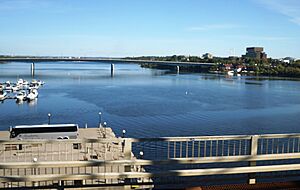Gatineau facts for kids
Quick facts for kids
Gatineau
|
|||||
|---|---|---|---|---|---|
| Ville de Gatineau | |||||
|
Clockwise from top left: Canadian Museum of History, downtown, Ottawa River, Macdonald-Cartier Bridge, and Rue de l'Hôtel-de-Ville.
|
|||||
|
|||||
| Nickname(s):
G-town
|
|||||
| Motto(s):
Fortunae meae, multorum faber ("Maker of my fate and that of many others")
|
|||||
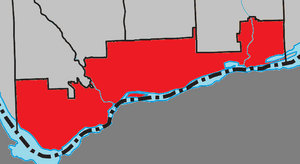
Location of Gatineau (red) with adjacent municipalities
|
|||||
| Country | Canada | ||||
| Province | Quebec | ||||
| Region | Outaouais | ||||
| RCM | None | ||||
| Constituted | 1 January 2002 | ||||
| Government | |||||
| • Type | Gatineau City Council | ||||
| Area | |||||
| • City | 381.30 km2 (147.22 sq mi) | ||||
| • Land | 341.84 km2 (131.99 sq mi) | ||||
| • Urban | 549.49 km2 (212.16 sq mi) | ||||
| • Metro | 8,046.99 km2 (3,106.96 sq mi) | ||||
| Population
(2021)
|
|||||
| • City | 291,041 (18th) | ||||
| • Density | 851.4/km2 (2,205/sq mi) | ||||
| • Urban | 1,068,821 (6th) | ||||
| • Urban density | 1,945.1/km2 (5,038/sq mi) | ||||
| • Metro | 1,488,307 (4th) | ||||
| • Metro density | 185.0/km2 (479/sq mi) | ||||
| • Pop 2011–2016 | |||||
| • Dwellings | 125,608 | ||||
| Time zone | UTC−5 (EST) | ||||
| • Summer (DST) | UTC−4 (EDT) | ||||
| Postal code(s) |
J8L, J8M, J8P, J8R, J8T, J8V, J8X to J8Z, J9A, J9H to J9J, various K1A (Government Offices)
|
||||
| Area codes | 819, 873, 468 | ||||
| GDP Per Capita | CAD$ 38 079 (2018) | ||||
Gatineau is a big city in southwestern Quebec, Canada. It sits on the north side of the Ottawa River, right across from Ottawa, Ontario. Gatineau is the largest city in the Outaouais region of Quebec. It's also part of Canada's National Capital Region.
In 2021, Gatineau was the fourth-largest city in Quebec, with about 291,000 people. When you include Ottawa, the whole area has over 1.4 million people. This makes it the fourth-largest city area in Canada. Gatineau is known for being very bilingual, meaning many people speak both French and English.
Contents
What's in a Name?
The name "Gatineau" has an interesting history. In 1613, the famous explorer Samuel de Champlain was the first European to mention "the river that comes from the north." But he didn't give it a name.
It wasn't until 1783 that the river was called "Lettinoe" in a report. Later maps used names like "Gatteno" and "Gatino." The name "Gatineau" first appeared on a map in 1821. Since then, the river has always been called the Gatineau.
There are two main ideas about where the name came from:
- Some believe it comes from the Anishinaabemowin language (spoken by the Algonquin Anishinaabeg). They say it might come from "Tenagatino Zibi."
- Others think it comes from a French family named Gastineau. One member, Nicolas Gastineau, was a fur trader.
Gatineau's Story
Before Europeans arrived, the Algonquin people lived in the Gatineau area. The city of Gatineau is built around an older area called Hull. This was the first European settlement in the National Capital Region.
Hull was started in 1800 by Philemon Wright on the north side of the Ottawa River. Wright hoped to create a farming community. But by 1806, he and his family started a lumber business. They floated the first large rafts of timber down the Ottawa River to Quebec City. The first settlement was called Wright's Town, but it was later renamed Hull in 1875.
Across the river, the city of Bytown (now Ottawa) was founded in 1832. In 2002, Hull joined with other towns to form the larger city of Gatineau.
In the 1800s, many immigrants from Ireland and Great Britain moved to Hull. Later, more and more French Canadians also came to the area for industrial jobs.
The Gatineau River, like the Ottawa River, was important for moving logs. Loggers would float timber down these rivers from lumber camps. This activity, called draveurs, ended a few years after 1987.
Most of the original Hull settlement from 1800 is gone. Big fires, especially one in 1900, destroyed the oldest parts of the town.
During the 1970s and 1980s, the old downtown of Hull was rebuilt. Many old buildings were taken down and replaced with large office buildings.
Where is Gatineau?
Gatineau is in southwestern Quebec, on the north bank of the Gatineau River. It's about 50 meters (164 feet) above sea level. The Gatineau Hills, which are part of the Laurentian Mountains, are nearby. These hills are great for skiing and snowboarding in winter.
The area is close to where the Canadian shield and the Saint Lawrence Lowlands meet. Small earthquakes happen here sometimes, but usually they are not very strong.
Gatineau has many parks and green spaces. The beautiful Gatineau Park covers almost 360 square kilometers of forest. It's one of the largest urban parks in the world. The park is perfect for hiking, biking, cross-country skiing, and has beaches. The Ottawa and Gatineau Rivers flow through the city, and you can even take boat rides on the Ottawa River.
Rivers and Lakes
All the water in Gatineau flows into the Ottawa River, which then goes into the St. Lawrence. The Ottawa River forms the city's southern border. Other rivers like the Lièvre and the Blanche also cross the city.
Gatineau has several lakes. Some of the most well-known are Lac Leamy, Lac Beauchamp, Lac des Fées, and Lac Pink. Pink Lake is special because it's a meromictic lake, meaning its layers of water don't mix.
Weather in Gatineau
Gatineau has a humid continental climate, which means it has four clear seasons. The average temperature is about 6.5 °C (43.7 °F).
Summer lasts from late June to late September. July is the hottest month, with average highs around 26 °C (78 °F). The cold season is from early December to early March. January is the coldest month, with average lows around -15 °C (5 °F). Gatineau gets a good amount of rain and snow throughout the year.
| Climate Data for Gatineau | ||||||||||||
|---|---|---|---|---|---|---|---|---|---|---|---|---|
| January | February | March | April | May | June | July | August | September | October | November | December | |
| Avg. Temperature °C (°F) | -9.8 °C
(14.3) °F |
-8.2 °C
(17.2) °F |
-2.8 °C
(26.9) °F |
5.1 °C
(41.1) °F |
13 °C
(55.4) °F |
17.9 °C
(64.3) °F |
20.8 °C
(69.4) °F |
19.9 °C
(67.9) °F |
16.2 °C
(61.2) °F |
8.9 °C
(48) °F |
2.1 °C
(35.7) °F |
-5.2 °C
(22.6) °F |
| Min. Temperature °C (°F) | -14 °C
(6.7) °F |
-12.5 °C
(9.5) °F |
-7.1 °C
(19.3) °F |
0.5 °C
(32.9) °F |
8.1 °C
(46.7) °F |
13.4 °C
(56.1) °F |
16.5 °C
(61.7) °F |
16.1 °C
(60.9) °F |
12.5 °C
(54.5) °F |
5.9 °C
(42.7) °F |
-0.5 °C
(31.1) °F |
-8.3 °C
(17) °F |
| Max. Temperature °C (°F) | -5 °C
(23.1) °F |
-2.9 °C
(26.8) °F |
2.4 °C
(36.3) °F |
10.6 °C
(51.2) °F |
18.5 °C
(65.4) °F |
23 °C
(73.4) °F |
25.5 °C
(78) °F |
24.4 °C
(75.9) °F |
20.8 °C
(69.4) °F |
12.7 °C
(54.9) °F |
5.5 °C
(42) °F |
-1.5 °C
(29.3) °F |
| Precipitation / Rainfall mm (in) | 78
(3) |
63
(2) |
74
(2) |
94
(3) |
92
(3) |
102
(4) |
101
(3) |
92
(3) |
97
(3) |
102
(4) |
87
(3) |
86
(3) |
| Humidity(%) | 76% | 72% | 69% | 63% | 65% | 70% | 70% | 72% | 74% | 75% | 78% | 79% |
| Rainy days (d) | 9 | 7 | 8 | 8 | 9 | 9 | 9 | 8 | 8 | 9 | 9 | 9 |
| avg. Sun hours (hours) | 4.0 | 4.8 | 6.3 | 7.9 | 9.2 | 10.2 | 10.6 | 9.2 | 7.3 | 5.4 | 3.9 | 2.9 |
Data: 1991 - 2021 Min. Temperature °C (°F), Max. Temperature °C (°F), Precipitation / Rainfall mm (in), Humidity, Rainy days. Data: 1999 - 2019: avg. Sun hours
Ottawa-Gatineau Area
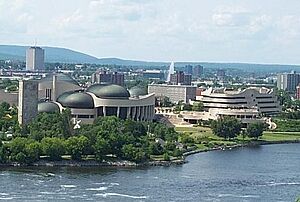
Gatineau is one of the two main parts of the National Capital Region. This area includes Ottawa, Ontario (Canada's capital), Gatineau, and the towns around them.
The National Capital Region has many fun places to visit. These include famous festivals, national museums, and cool buildings. Gatineau is home to the Canadian Museum of History, which is one of Canada's most visited museums. It was designed by Douglas Cardinal, a famous Indigenous architect.
How Gatineau Grew
On January 1, 2002, five different towns joined together to create the new city of Gatineau. These towns were:
- Aylmer
- Buckingham
- Hull
- Gatineau (the original town)
- Masson-Angers
Even though Hull was the oldest town, the name Gatineau was chosen for the new city. This was because the original Gatineau had more people. Also, the name Gatineau was already well-known in the area, used for the county, valley, hills, park, and main river.
Later, people in Aylmer, Buckingham, Hull, and Masson-Angers voted on whether to separate again. But most people decided to stay together as one big city.
| Division of population by sector in the city of Gatineau. | ||||
|---|---|---|---|---|
| Gatineau | 45.4% | |||
| Hull | 29.2% | |||
| Aylmer | 15.9% | |||
| Buckingham | 5.1% | |||
| Masson-Angers | 4.3% | |||
Gatineau's Neighbourhoods
Gatineau is divided into 5 main areas, or sectors: Hull, Aylmer, Gatineau, Masson-Angers, and Buckingham.
People of Gatineau
In 2021, Gatineau had a population of about 291,041 people. This was an increase from 2016. Most people live in the city parts of Aylmer, Hull, and the original Gatineau. Buckingham and Masson-Angers are more rural. Gatineau is the fourth-largest city in Quebec.
Gatineau is a very diverse city. Each year, between 800 and 1,000 new people move to Gatineau from about sixty different countries. This makes the city's culture very rich and interesting.
Languages Spoken
In Gatineau, most people speak French. In 2021, about 71% of residents said French was their first language. About 11.8% said English was their first language. Many people in Gatineau are bilingual, meaning they can speak both French and English very well.
| Canada Census Mother Tongue - Gatineau, Quebec | ||||||||||||||||||
|---|---|---|---|---|---|---|---|---|---|---|---|---|---|---|---|---|---|---|
| Census | Total |
|
|
|
|
|||||||||||||
| Year | Responses | Count | Trend | Pop % | Count | Trend | Pop % | Count | Trend | Pop % | Count | Trend | Pop % | |||||
|
|
|
204,290 | 71.1% | 33,825 | 11.8 | 8,640 | 3% | 34,165 | 11.9% | |||||||||
|
|
|
205,335 | 75.14% | 30,660 | 11.22% | 4,635 | 1.69% | 29,275 | 10.7% | |||||||||
|
|
|
203,360 | 77.24% | 29,060 | 11.04% | 4,415 | 1.6% | 23,855 | 9.06% | |||||||||
|
|
|
191,445 | 79.77% | 25,365 | 10.56% | 2,670 | 1.11% | 20,505 | 8.54% | |||||||||
|
|
|
183,455 | 81.6% | 24,115 | 10.7% | 2,810 | 1.25% | 14,380 | 6.39% | |||||||||
|
|
|
177,065 | n/a | 81.97% | 23,995 | n/a | 11.1% | 3,005 | n/a | 1.39% | 10,985 | n/a | 5.08% | |||||
Religions in Gatineau
Most people in Gatineau are Christian, making up about 62.6% of the population in 2021. About 30.8% of people said they had no religion. Other religions like Islam, Buddhism, and Hinduism are also present in the city.
Gatineau's Economy
Gatineau's economy used to be mostly about making paper. But now, many government offices are located here. This is because Gatineau is very close to Ottawa, the capital of Canada.
The Canadian government has a rule to spread jobs on both sides of the Ottawa River. So, many large office buildings were built in downtown Gatineau for government workers. Some important government groups with offices here include Public Works and Government Services Canada and Environment Canada.
Gatineau is also a key center for the Outaouais region. It has major hospitals and colleges. Other important parts of the economy are healthcare, tourism, education, and small businesses.
The Gatineau-Ottawa area has over 1,900 technology companies. These companies employ almost 80,000 people. There are also many research centers and universities.
Arts and Culture
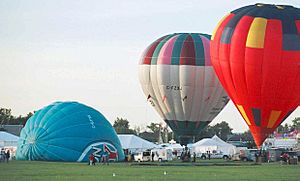
Gatineau has many fun attractions and cultural events. It's home to national museums like the Canadian Museum of History and the Canadian Children's Museum. The "Vieux-Hull" area has many restaurants and bars. It's a popular spot for young people from Ontario because the legal drinking age in Quebec is 18, while in Ontario it's 19.
Shopping in Gatineau
The biggest shopping mall in Gatineau is Les Promenades. It's located at a busy intersection and is easy to get to from Autoroute 50.
Arts and Entertainment Venues
The Maison de la culture is a big building for arts. It has the Salle Odyssée, which is an 830-seat theater for performances. It also has an art exhibition center, a library, and hosts other cultural activities.
A newer place is the Centre Slush Puppy. It's a 4,000-seat arena with three ice rinks. It's home to the QMJHL hockey team, the Les Olympiques. It also hosts concerts by big artists.
Festivals and Fun Events
The Casino du Lac-Leamy is a popular tourist spot. In August, it hosts an international fireworks competition. Different countries compete, and the winner gets a Prix Zeus award.
In early September, Gatineau hosts an annual hot air balloon festival. The sky fills with colorful balloons! One of Gatineau's parks, Jacques Cartier Park, is used during the popular Winterlude festival. In December, the Gatineau Playground Festival offers lots of games and activities for kids and adults.
Music Scene
While many big artists perform in Ottawa, the Centre Slush Puppy in Gatineau is bringing more events to the city. Gatineau is home to many French and English-speaking artists.
Parks and Green Spaces
Gatineau has many parks. Some are well-kept playgrounds, while others, like Lac Beauchamp Park, are wilder green areas. These often connect with the forests and fields nearby. The Gatineau Hills are visible in the background and are part of the huge Canadian Shield.
Sports in Gatineau
Gatineau has several sports teams:
- Gatineau Fusion (Ringette)
- Gatineau Olympiques (Junior Hockey)
- Gatineau Jr. Olympiques (Junior Ice Hockey)
- Gatineau Vikings (Canadian Football)
- Tyran de Gatineau (Junior Elite Baseball)
- L'Intrépides de Gatineau (Midget AAA Hockey)
- La Machine de l'Outaouais (Kin-Ball)
Since 2010, Gatineau has also hosted a professional road cycling event for women, the Grand Prix Cycliste Gatineau.
Getting Around Gatineau
The Gatineau-Ottawa Executive Airport is Gatineau's local airport for smaller planes. Most people in Gatineau use the larger Ottawa Macdonald–Cartier International Airport or travel to Montreal's airport.
Public Transportation
Ottawa and Gatineau have separate bus systems, OC Transpo and the Société de transport de l'Outaouais. You can use passes and transfers between them without extra cost. There are plans for a light rail system to connect Gatineau to Ottawa.
Roads and Highways
Many roads in Gatineau lead to bridges that cross into Ottawa. However, once in Ottawa, these roads go into the busy downtown area or residential streets. There isn't a direct highway on the Quebec side that connects Gatineau to Montreal. Most people going to Montreal from Gatineau cross into Ottawa first and use Ontario highways. However, the recently completed Autoroute 50 might help connect Gatineau to Montreal more directly.
Learning in Gatineau
The education system in Quebec is a bit different. After 5 years of high school, students go to a special school called CEGEP (Collège d'enseignement général et professionnel). This is needed if they want to go to university in Quebec. CEGEPs offer two-year programs to prepare for university or three-year technical programs.
Gatineau has a high number of people who have finished university. Many people in Gatineau also speak both English and French fluently.
The main campus of the Université du Québec en Outaouais (UQO) is in Gatineau. It has over 5,500 students, mostly in social science programs. UQO is known for its cyber-psychology lab. Many students from Quebec also go to universities in Ottawa or Montreal.
Gatineau also has two CEGEPs: the French-speaking Cégep de l'Outaouais and the English-speaking Heritage College. There are also private high schools and public school boards for both French and English students.
Since 1995, the National Autonomous University of Mexico (UNAM) has a campus in Gatineau.
Medical Campus
In 2019, McGill University announced plans for a new medical campus in Gatineau. This campus will offer a French-language medical program. Students will be able to complete their medical training entirely in Gatineau.
Media in Gatineau
Gatineau is home to several TV and radio stations that serve the Ottawa-Gatineau area. Most of these stations broadcast in French.
Weekly newspapers in Gatineau include Le Bulletin d'Aylmer (which is bilingual) and The West Quebec Post. While Gatineau doesn't have its own daily newspaper, people read daily newspapers from Ottawa, like the French Le Droit and the English Ottawa Citizen and Ottawa Sun.
The Canadian Radio-television and Telecommunications Commission (CRTC), which regulates broadcasting in Canada, is also based in Gatineau.
Famous People from Gatineau
Many notable people come from Gatineau, including:
- Phillippe Aumont (baseball player)
- Dave Leduc (martial artist)
- Eva Avila (singer)
- Daniel Brière (hockey player)
- Daniel Lanois (music producer)
- Denis Savard (hockey player)
- Maxim Tissot (soccer player)
- Evil Uno (wrestler)
- Philemon Wright (founder of Hull)
Images for kids
See also
 In Spanish: Gatineau para niños
In Spanish: Gatineau para niños




